



Next: NICMOS Observes the Galactic
Up: NICMOS Science
Previous: Unusual Emission near a
Subsections
W. Schmutz
Institute of Astronomy, ETH Zentrum, CH-8092 Zürich, Switzerland
W. D. Vacca, L. Close, and J. Rayner
Institute for Astronomy, Honolulu, Hl 96822
T. R. Geballe
Joint Astronomy Centre, Hilo, Hl 96720, USA
H. Schild and R. Walder
Institute of Astronomy, Zürich, Switzerland
Abstract:
Models of the evolution of massive binaries predict that only a few such
objects should survive the common envelope phase and result in systems
containing a compact object plus a Wolf-Rayet star (c+WR). According
to these models, a vast amount of stellar material is lost during the
common envelope phase prior to the c+WR phase. We are attempting to test
these models by searching for the presence of such circumbinary material
around the only known c+WR object: Cyg X-3. Since the large reddening
towards Cyg X-3 prevents any investigation in the optical, deep infrared
exposures of Cyg X-3 with the NICMOS NIC-2 camera aboard HST and the
Pa

narrow band filter have been used to image the system at
high spatial resolution.
21.1
The HST images have only recently been acquired and their analysis is currently
underway. Here we report the possible detection of emission at a distance of
about 03. This result is preliminary and needs confirmation by
NIC-1 observations with its better sampling of the stellar profile.
binaries: close - stars: individual: Cyg X-3 - stars: Wolf-Rayet
- infrared: stars - circumstellar matter
Cyg X-3 is one of the most luminous X-ray sources in the sky. On the
basis of its periodic X-ray variability, it has been interpreted as a
binary system in which substantial mass transfer occurs from a
companion onto a collapsed object (Bonnet-Bidaud & Chardin 1988).
Unfortunately, the enormous
reddening toward Cyg X-3 (EB-V>5) effectively prevents any optical
studies of this system (V > 24,
 ,
,
 ).
However, recent infrared observations of
Cyg X-3 have provided important information regarding the nature of
this object. The first K-band spectrum of the system, obtained by van
Kerkwijk et al. (1992), revealed strong and broad emission lines of He
I and He II and it was suggested that the mass donor is a
Wolf-Rayet (WR) star. Schmutz et al. (1996) found that the K-band emission
lines exhibited periodic wavelength shifts, presumably due to the
orbital motion of the WR star around the compact companion. The mass
function for the system was found to be 2.3 and reasonable estimates of
the mass of the WR star yielded a mass of the compact object of
).
However, recent infrared observations of
Cyg X-3 have provided important information regarding the nature of
this object. The first K-band spectrum of the system, obtained by van
Kerkwijk et al. (1992), revealed strong and broad emission lines of He
I and He II and it was suggested that the mass donor is a
Wolf-Rayet (WR) star. Schmutz et al. (1996) found that the K-band emission
lines exhibited periodic wavelength shifts, presumably due to the
orbital motion of the WR star around the compact companion. The mass
function for the system was found to be 2.3 and reasonable estimates of
the mass of the WR star yielded a mass of the compact object of
 M
M ;
thus, the compact object is an excellent black
hole candidate. These results strengthen the suggestion that Cyg X-3 is
representative of the endpoint of massive binary evolution.
;
thus, the compact object is an excellent black
hole candidate. These results strengthen the suggestion that Cyg X-3 is
representative of the endpoint of massive binary evolution.
Despite theoretical predictions for the formation of systems
composed of a WR star and a compact companion
(van den Heuvel & de Loore 1973), observational searches
for such objects had yielded negative results
(Willis et al. 1989; Moffat 1992; St-Louis et al. 1993) until the
observation by van Kerkwijk et al. (1992). The evolutionary steps for the
formation of such a system are O+O
 RSG+O
RSG+O
 WR+O
WR+O
 SN+O
SN+O
 c+O
c+O
 c+RSG
c+RSG
 c+WR, where c denotes a compact object. Numerical
calculations (Iben & Livio 1993)
indicate that the common envelope phase (c+RSG) is the
critical phase in the evolution, and few c+WR systems are expected to
exist as a result of the complete disruption of the secondary during
this phase. The fact that only one c+WR system has been found to date
indicates that it is indeed rare for a system to survive the common
envelope phase. Thus Cyg X-3 provides an excellent and completely unique
laboratory for testing the models of massive binary evolution.
c+WR, where c denotes a compact object. Numerical
calculations (Iben & Livio 1993)
indicate that the common envelope phase (c+RSG) is the
critical phase in the evolution, and few c+WR systems are expected to
exist as a result of the complete disruption of the secondary during
this phase. The fact that only one c+WR system has been found to date
indicates that it is indeed rare for a system to survive the common
envelope phase. Thus Cyg X-3 provides an excellent and completely unique
laboratory for testing the models of massive binary evolution.
It has been estimated that on the order of a few tens of solar masses of
material was lost during the common envelope phase of Cyg
X-3 and various models predict that the material should be concentrated
in the orbital plane (Livio & Soker 1988; Terman et al. 1994).
The current fast wind from the WR
star should interact with this slowly expanding circumbinary
material. This situation should lead to a ``ring'' of condensed matter
around the system, probably broken up into individual knots due to
Rayleigh-Taylor and other instabilities
(Garcia-Segura & Mac Low 1995), similar to the ring
observed around SN1987A. This is demonstrated in Fig. 1, which presents
predictions for the density contours resulting from
a 2-D numerical simulation in which a fast stellar wind collides
with a slowly expanding shell
(Folini & Walder 1998, personal communication;
see also Walder & Folini 1998).
Figure 1:
2-D simulation of the collision of a fast wind with a slowly
expanding shell. The developing Rayleigh-Taylor instabilities are
traced by density contours. The rectangular grid outlines different
levels of the adaptive mesh refinement algorithm. This figure demonstrates
that we should expect many small regions with
high density rather than a shell with uniform density. The concentration
into high density knots is even more pronounced when time-dependent
cooling is included in the calculations.
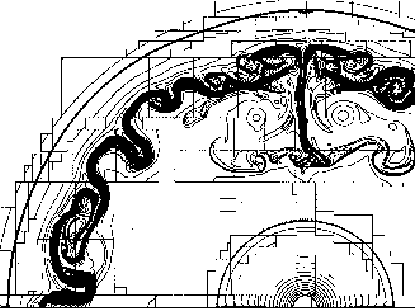 |
Localized density enhancements such as
those seen in this figure would be observed as knots.
The formation of high density knots is
even more pronounced if the time dependence of the cooling is taken
into account, as this leads to further compression and enhancement.
The dense regions are relatively cool (with low gas pressure) and
the material is ionized by the X-ray emission from the black hole and the
strong Lyman continuum flux from the Wolf-Rayet star. Shock heated
layers are expected to have fairly low density and therefore contribute
little to the emission measure of the the strong nebular recombination lines.
The size of the expected emission region should depend on the velocity
of expansion of the shell of material expelled during the common
envelope phase and on the time since the common envelope phase. The
expansion velocity in turn, is given by the accumulated momentum from
the wind that accelerated the shell's mass. (The initial expansion
from the shell can probably be neglected.) For a typical duration of the
WR phase,
 yr, and an assumed average expansion
of
yr, and an assumed average expansion
of  kms-1, we estimate an extension of 0.3pc. At
10kpc, the commonly adopted distance of Cyg X-3 (Dickey 1983), this
corresponds to an angular separation of 6. This estimate is
highly uncertain, and a search for nebular emission at both larger and
smaller separations is also necessary. For example, typical sizes of WR ring
nebulae are on the order of a few pc (Tutukov 1982), i.e. on the order
of 20 at a distance of Cyg X-3.
kms-1, we estimate an extension of 0.3pc. At
10kpc, the commonly adopted distance of Cyg X-3 (Dickey 1983), this
corresponds to an angular separation of 6. This estimate is
highly uncertain, and a search for nebular emission at both larger and
smaller separations is also necessary. For example, typical sizes of WR ring
nebulae are on the order of a few pc (Tutukov 1982), i.e. on the order
of 20 at a distance of Cyg X-3.
The morphology of the emission nebula can provide observational
constraints for the predictions of the common envelope mass loss and
the nebular emission can be used to place constraints on the initial
mass of the system. Contamination by swept up interstellar material
can be excluded as the source of any possible nebular emission
detected relatively close to Cyg X-3 (i.e. anywhere within the field of
view of the NIC-2 camera), because the predicted SN explosion prior to
the common envelope phase should have cleared out this region.
Detected nebular Pa emission would therefore allow us to
calculate the circumstellar mass and obtain an estimate of the lower
limit for the initial mass of the WR star. This assumes that most of
the ionized material is density bounded. Alternatively, if the nebula
is ionization bounded, then we can probe the far UV radiation field,
especially if we detect the nebula in the light of He I,
[Fe II], and [S III]. In either case, an unambiguous
detection of nebular emission close to Cyg X-3 would confirm the
predicted common envelope phase with its dramatic mass loss.
emission would therefore allow us to
calculate the circumstellar mass and obtain an estimate of the lower
limit for the initial mass of the WR star. This assumes that most of
the ionized material is density bounded. Alternatively, if the nebula
is ionization bounded, then we can probe the far UV radiation field,
especially if we detect the nebula in the light of He I,
[Fe II], and [S III]. In either case, an unambiguous
detection of nebular emission close to Cyg X-3 would confirm the
predicted common envelope phase with its dramatic mass loss.
Figure:
Left panel:
H-band image of an 18" x 18" field around Cyg X-3, obtained
with the Adaptive Optics system on the CFHT 3.6m telescope on 15 July
1997 (Vacca et al. 1998). North is up and East is to the left.
The FWHM is approximately 05; the white cores of
sources X and D have diameters approximately equal to the FWHM.
Sources are labeled according to Joyce (1990) and Fender
& Bell-Burnell (1996); X denotes Cyg X-3.
Right panel: The H-band image of the left panel after 300 iterations
with the algorithm of Lucy-Richardson, with the PSF made from Z and D.
The stellar cores (white) now have a FWHM of about 02.
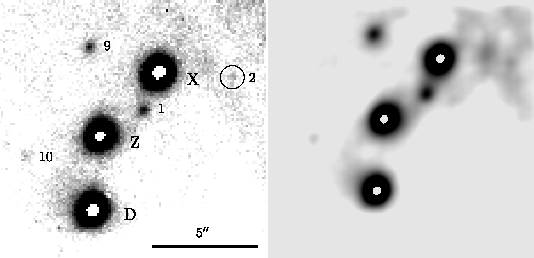 |
There is observational evidence for
extended nebular emission associated with the Cyg X-3 system.
Spectroscopic observations of Cyg X-3, obtained with  seeing and slit sizes, reveal the presence of narrow emission lines
superimposed on the broad WR emission features. An example of this
emission can be seen in Figs. 3 and 4 of Schmutz et al. (1996).
These narrow lines are
much stronger than any variable emission features often seen on top of
the WR emission lines in the spectra of WR binary systems and attributed to the wind-wind
collision zones (Moffat et al. 1996).
Therefore, the narrow emissions in Cyg X-3 are
probably not related to the WR wind but originate at larger distances
from the system.
seeing and slit sizes, reveal the presence of narrow emission lines
superimposed on the broad WR emission features. An example of this
emission can be seen in Figs. 3 and 4 of Schmutz et al. (1996).
These narrow lines are
much stronger than any variable emission features often seen on top of
the WR emission lines in the spectra of WR binary systems and attributed to the wind-wind
collision zones (Moffat et al. 1996).
Therefore, the narrow emissions in Cyg X-3 are
probably not related to the WR wind but originate at larger distances
from the system.
We have recently obtained ground-based near-infrared images of Cyg X-3,
using adaptive optics (AO) techniques, which also seem to suggest that
extended nebular emission may be present in this system. In Fig. 2
(from Vacca et al. 1998)
we present our H-band image, obtained with the University of Hawaii Adaptive
Optics system on the CFHT. The total
integration time for this image was 600sec. It was constructed by
co-adding 20 individual frames, each with an exposure time of
30sec. The FWHM of this image is about 05.
Because the only suitable reference star that can be used to make the
AO wavefront corrections is 30 away from Cyg X-3 and has a
brightness of only V=15 (both values are at the limit of what can be
used in current AO systems), our exposure resulted in a PSF which is
slightly elongated to the SE, in the direction of this reference star.
Nevertheless, this image indicated that we may have detected extended
emission to the west of Cyg X-3 in the region of object #2.
Unfortunately the detection is marginal because of problems with the
flat-fielding and background sky subtraction. But it is sufficiently far
from the point sources that we thought it might be real until we
saw the HST NICMOS images. In fact, it is an artifact
resulting from the flat-fielding.
Recently, Ogley et al. (1997) have reported that Cyg X-3 appears to
be slightly extended in their deep K-band images and they suggested
that a second point source, a factor of 11 fainter than the primary
object, was located within 056 of Cyg X-3. (Dilution by a second
stellar object might also explain why the broad WR emission lines seen
in the K-band spectra have unusually small equivalent widths for a WR
star (van Kerkwijk et al. 1992; van Kerkwijk 1993; Schmutz et al. 1996).
However, our AO images (Fig. 2; Vacca et al. 1998), do not
confirm this suggestion. Despite the slight elongation of our
PSF, a second point source with the claimed separation and brightness
would be easily recognizable on our image. (We also do not find a
second source in the K-band image). NICMOS images, with their much
smaller PSF cores, easily settle this question and place much stricter
limits on the brightness and separation of any possible additional
source.
Cyg X-3 was observed with HST and NICMOS over 3 orbits on 1998 March 13.
We used the NIC-2 camera
in combination with the narrow band filters F187N, centered on Pa ,
and F190N, for the adjacent continuum region.
For both filters we obtained 4 dither positions
with 2 step size. The total exposure times were 68 min and
34 min for the filters F187, and F190N, respectively.
For the analysis presented here we used the mosaiced images as delivered
by the standard STScI pipeline. The standard processing leaves
a clearly visible offset in the bias levels of the four
detector quadrants but otherwise, particularly in terms of image sharpness,
the processing resulted in excellent images.
,
and F190N, for the adjacent continuum region.
For both filters we obtained 4 dither positions
with 2 step size. The total exposure times were 68 min and
34 min for the filters F187, and F190N, respectively.
For the analysis presented here we used the mosaiced images as delivered
by the standard STScI pipeline. The standard processing leaves
a clearly visible offset in the bias levels of the four
detector quadrants but otherwise, particularly in terms of image sharpness,
the processing resulted in excellent images.
In Fig. 3 we show the resulting image of the Cyg X-3
 field.
field.
Figure:
Mosaiced NIC-2 image of
 min exposures
through the Pa
min exposures
through the Pa filter F187N. The observation angle was
filter F187N. The observation angle was
 ,
i.e. north is approximately to the right and east to the top. The
field of view of one NIC-2 exposure is
,
i.e. north is approximately to the right and east to the top. The
field of view of one NIC-2 exposure is
 and the mosaiced image has
an extension of
and the mosaiced image has
an extension of
 pixels or
pixels or
 .
The strongest source near the center is Cyg X-3 and the next brightest object
to the south-east is star Z. Star D is the object to the south of star Z
about as bright as Z.
The grey scale representation
is chosen to enhance faint features just above the background. Due to
this representation the different bias offsets in the four detector
quadrants are very obvious.
.
The strongest source near the center is Cyg X-3 and the next brightest object
to the south-east is star Z. Star D is the object to the south of star Z
about as bright as Z.
The grey scale representation
is chosen to enhance faint features just above the background. Due to
this representation the different bias offsets in the four detector
quadrants are very obvious.
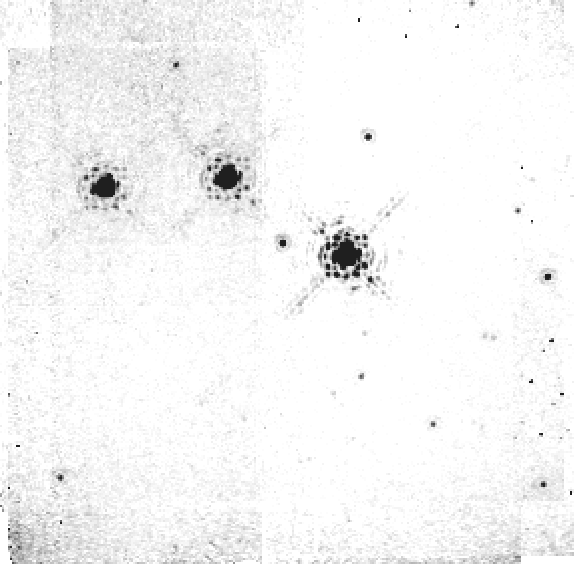 |
All previously known sources in the field are clearly detected; a comparison
with Fig. 2 shows the presence of objects 1, 2, 9, and 10. In addition,
there are about half a dozen newly discovered faint objects in the image.
With the HST NICMOS observations we were searching for 4 types of emission:
- 1.
- nebular emission close (
 )
to Cyg X-3;
)
to Cyg X-3;
- 2.
- nebular emission in the vicinity of Cyg X-3 (
 );
);
- 3.
- extended nebular emission in the general area of Cyg X-3;
- 4.
- continuum emission from a source at about 05 from Cyg X-3.
Each of these items corresponds to a possibility discussed in the Sects. 2
and 3. The easiest item to discuss is item #4. Ogley et al. (1997)
suspected an object about 2.6mag fainter and 056 to the west of
the main object. In Fig. 4 we show the cores of the stellar images of the
Figure 4:
As Fig. 3 but the grey scale representation chosen such that
the cores of the stellar images are visible.
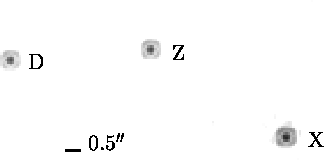 |
objects X, Z, and D. The lightest grey level represents
emission about 4mag fainter than the central pixel. We
conclude that at the time of our HST observation there was no
object present with the brightness and distance suggested by
Ogley et al. (1997). Thus, we confirm the results of Vacca et al. (1998) based on AO images.
We can also address item #2 relatively easily. Using the intensities of the
stars D and Z we scale the image F190N with a factor of 0.97
to that of F187N and we produce a difference image F187N-F190N.
An investigation of this difference image does not reveal any extended
emission. The only signatures left above the background
are strong Pa emission at the location
of Cyg X-3 and imperfect cancelations of the stellar images of
star D and Z that leave paired positive and negative intensities.
(The negative-positive residuals from stars D and Z integrate to zero
intensity, of course, because we have used them to scale the
continuum observation to that of the Pa
emission at the location
of Cyg X-3 and imperfect cancelations of the stellar images of
star D and Z that leave paired positive and negative intensities.
(The negative-positive residuals from stars D and Z integrate to zero
intensity, of course, because we have used them to scale the
continuum observation to that of the Pa .) The strength of the
Pa
.) The strength of the
Pa excess emission of Cyg X-3 is 40% of the continuum. This
value agrees very well with the emission strength estimated from ground-based
spectroscopy of Cyg X-3 (see Fig. 4 of Schmutz et al. 1996).
In fact, the emission is not from Pa
excess emission of Cyg X-3 is 40% of the continuum. This
value agrees very well with the emission strength estimated from ground-based
spectroscopy of Cyg X-3 (see Fig. 4 of Schmutz et al. 1996).
In fact, the emission is not from Pa at all, but rather the broad
He II 6-8 stellar wind line.
at all, but rather the broad
He II 6-8 stellar wind line.
With the difference image described above we have also addressed, in part,
item #3. However, if there is a nebular structure like a ring
nebulae around Wolf-Rayet stars then this would be outside the field
of the NIC-2 camera. We also have Pa images of NIC-1 and NIC-3
that are obtained in parallel with the NIC-2 exposures. With the
parallel exposures we probe regions about 30 and 80 to the west of Cyg X-3. Although these images are not in focus they
would still allow to detect extended nebular emission. In the difference
images of NIC-1 and NIC-3 there is also no obvious nebular emission.
Of course, with this parallel exposures we are only covering only a small
fraction
of the total area out to, say, 100. Thus, item #3 cannot
be addressed conclusively with our HST NICMOS observations.
images of NIC-1 and NIC-3
that are obtained in parallel with the NIC-2 exposures. With the
parallel exposures we probe regions about 30 and 80 to the west of Cyg X-3. Although these images are not in focus they
would still allow to detect extended nebular emission. In the difference
images of NIC-1 and NIC-3 there is also no obvious nebular emission.
Of course, with this parallel exposures we are only covering only a small
fraction
of the total area out to, say, 100. Thus, item #3 cannot
be addressed conclusively with our HST NICMOS observations.
The only remaining issue is item # 1, nebular emission close
(i.e.  )
to Cyg X-3. The detection of such emission requires
a deconvolution of the stellar image of Cyg X-3. As can be seen on Fig. 3
the point-spread function (PSF) of NICMOS is quite complicated. But the good news
is that it is supposed to be very reproducible, apart for some ``breathing''
effects which change the focus during an orbit.
)
to Cyg X-3. The detection of such emission requires
a deconvolution of the stellar image of Cyg X-3. As can be seen on Fig. 3
the point-spread function (PSF) of NICMOS is quite complicated. But the good news
is that it is supposed to be very reproducible, apart for some ``breathing''
effects which change the focus during an orbit.
Figure:
Deconvolved NIC-2 F187N Pa image using the image restoration scheme
by Lucy and Richardson as implemented in MIDAS. The result shown is after
80 iterations; the results after 40 or 120 iterations look very similar.
For the PSF the F190N image of Cyg X-3 was used.
Left panel: The
image using the image restoration scheme
by Lucy and Richardson as implemented in MIDAS. The result shown is after
80 iterations; the results after 40 or 120 iterations look very similar.
For the PSF the F190N image of Cyg X-3 was used.
Left panel: The
 region around star D.
Right panel: The
region around star D.
Right panel: The
 region around Cyg X-3. This region
also includes star 1 (seen at the left).
region around Cyg X-3. This region
also includes star 1 (seen at the left).
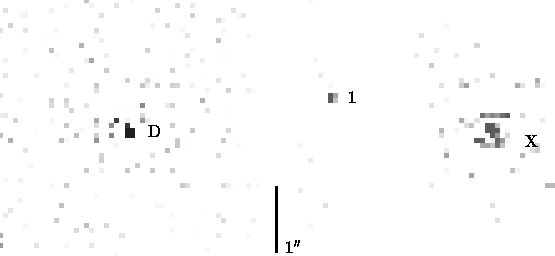 |
The best PSF template available for these observations is
that of Cyg X-3 itself
on the F190N image.
The difference in wavelength is small so that the F190N PSF is only
about 1.6% more extended than that expected for the F187N image. For
the preliminary analysis presented here we disregard this difference.
In Fig. 5 we present the results of a deconvolution with the
Lucy-Richardson restoration algorithm as implemented in MIDAS.
In the left panel we see that our PSF agrees very well with
the Pa image of star D; the deconvolution of this star has produced a
diffraction limited point source with no residual wings.
On the other hand, the profile of the deconvolved image of
Cyg X-3 is more extended than a pure point source. There is an
extended structure to the east and a less bright one to the west.
Therefore, Cyg X-3 appears to be more extended in Pa
image of star D; the deconvolution of this star has produced a
diffraction limited point source with no residual wings.
On the other hand, the profile of the deconvolved image of
Cyg X-3 is more extended than a pure point source. There is an
extended structure to the east and a less bright one to the west.
Therefore, Cyg X-3 appears to be more extended in Pa than it
is in the continuum image.
The number of iterations turned out to be non-critical
because the basic result, the extended structures to the east and west,
is robust. The intensity in the east feature is comparable to that of
star 1.
than it
is in the continuum image.
The number of iterations turned out to be non-critical
because the basic result, the extended structures to the east and west,
is robust. The intensity in the east feature is comparable to that of
star 1.
The extended nebular emission can also be detected in the original
image. In Fig. 6 we plot a west-east cut
Figure:
West-east crosscut, i.e. from bottom to top in Figs. 5,
through the NIC-2 F187N image of Cyg X-3 (dashed) and of F190N (dotted).
The 5 central columns are averaged and the central intensity of the
F190N cut
is scaled to that of the F187N. Excess emission in the east wing of Cyg X-3
is visible, at a distance of 02-03 from the center
(1 pixel
 ).
).
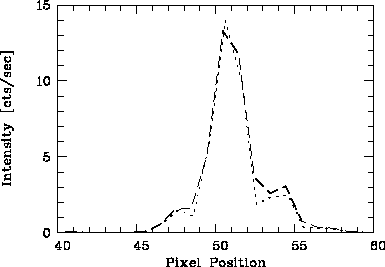 |
through the profiles of Cyg X-3 in the F187N and F190N images. The
lines represents the average of the 5 central columns. The excess
emission detected by deconvolution algorithm in Fig. 5 can easily be
seen 02-03 east of the main peak; there is also a
difference between the two profiles, although less pronounced, to the
west. The uncertainties of the profiles at a level of 2 and 3 counts
per second is 2% and 1%, respectively. (The total integration time
was 4096 sec for the F187N exposure and 2048 sec in the F190N image.)
Therefore, the difference between the two curves on the east side is at
a level of about 10 .
Because the F190N image has been used as
the PSF template for the deconvolution, we also know that the Cyg X-3
F190N profile agrees well with that of star D and Z in the F187N
exposure. Nevertheless, despite the high confidence level, it is still
possible that the emission detected close to Cyg X-3 results simply
from spatial and/or temporal variations of the PSF, and hence a
mismatch between the true PSF for Cyg X-3 and the PSF used to perform
the deconvolution.
.
Because the F190N image has been used as
the PSF template for the deconvolution, we also know that the Cyg X-3
F190N profile agrees well with that of star D and Z in the F187N
exposure. Nevertheless, despite the high confidence level, it is still
possible that the emission detected close to Cyg X-3 results simply
from spatial and/or temporal variations of the PSF, and hence a
mismatch between the true PSF for Cyg X-3 and the PSF used to perform
the deconvolution.
In view of the importance of Cyg X-3 to the understanding of massive
binary evolution -- as the only representative of the c+WR class --
we have searched for nebular emission that would testify to the events
during its previous evolutionary phase. We suspect that the previous
phase was a common envelope phase which implies that the non-degenerate
star has lost a substantial fraction of its mass. This mass is expected
to be still around the system, probably in a ring.
To date, there have been no clear detections of emission around Cyg X-3.
However, on the basis of the first part of our HST observations, we report
here the possible detection of matter close to Cyg X-3.
Our result is preliminary and at this stage of the analysis it is still not
clear whether the features seen are artifacts produced by subtle
imperfections in our PSF. Clearly, we need a better sampling of the
profiles of the Cyg X-3 image and of the PSF. We hope to
achieve this in an upcoming HST observation with NIC-1 camera. If the extended
nebular emission is confirmed, we will estimate the mass lost from the
donor star during the common envelope phase. This result could have a
profound impact on models of binary evolution.
WS is grateful to R. Hook and S. Stolovy for enlightening discussions
on the properties of NICMOS PSF. WDV is grateful to Alan Stockton for
partial support. Support for this work was also provided by NASA through
grant number G)-07838.01-96A from the Space Telescope Science Institute, which is
operated by AURA, Inc., under NASA contract NAS5-26555.
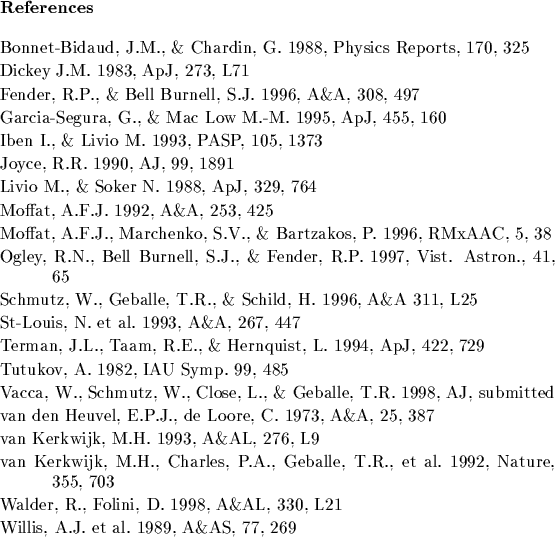




Next: NICMOS Observes the Galactic
Up: NICMOS Science
Previous: Unusual Emission near a
Norbert Pirzkal
1998-07-09






